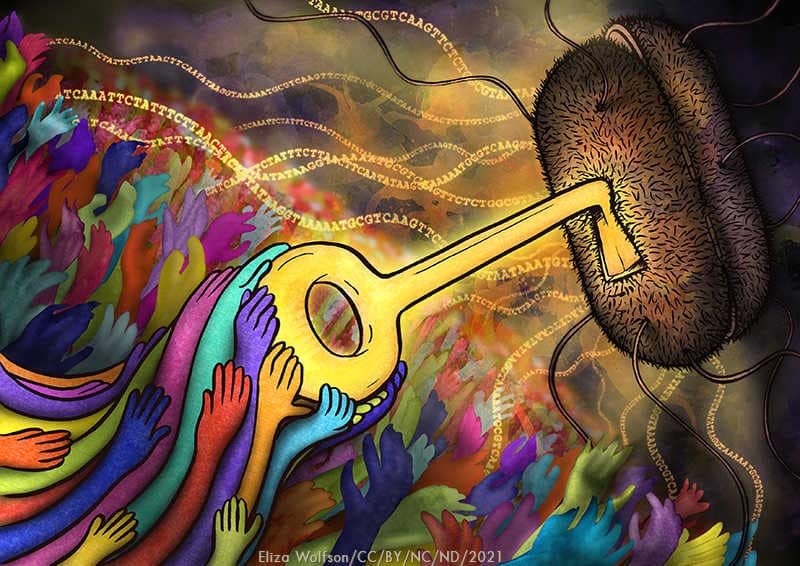Newsletter Signup - Under Article / In Page
"*" indicates required fields
An international academic team has made strides in carrying out genome sequencing faster and more cheaply in low- and middle- income nations. This could improve the control of potentially lethal salmonella infections and propel research into vaccines.
As the price of DNA sequencing continues to fall, genomics and bioinformatics firms are drawing ever more attention from investors. A big area where rapid genomics is becoming paramount is the fight against infectious diseases. For example, the sequencing of the coronavirus genome in 2020 turbo-charged the development of Covid-19 vaccines. And genomic surveillance continues to be vital for tracking the emergence of variants of concern.
Genomics can empower low- and middle-income countries to fight neglected infectious diseases, such as non-typhoidal salmonella infections in sub-Saharan Africa. However, carrying out sequencing and bioinformatics in some communities can be a tough task.
“Whole genome sequencing can give us information about the epidemiology, virulence, and antimicrobial resistance of pathogens, allowing us to design strategies for identifying, tracking, and preventing the spread of bacterial infections,” said Blanca Perez-Sepulveda, Postdoctoral Research Associate at the Institute of Infection, Veterinary and Ecological Sciences at the University of Liverpool, UK.
“But when access to genomic technology is limited or outdated, it is not possible to understand which bacteria are currently causing disease across the world,” she added.
Perez-Sepulveda and a team of other academic researchers around the world have worked to democratize large-scale bacterial genomics via an initiative called the 10,000 Salmonella Genomes Project (10KSG). The project was launched in 2017 to collect genetic material from the gut pathogen Salmonella enterica, which is commonly passed to humans via tainted food and can cause life-threatening infections if it reaches the bloodstream.
According to recent results, the 10KSG project hit its goal by collecting genetic data from 10,419 bacterial samples from low- and middle-income regions in under a year. Each genome cost less than €9 ($10) to sequence — a major milestone compared to before the project, where large-scale sequencing would have cost up to ten times this amount.
According to Juanjo Infante, CEO of the Spanish biotech Vaxdyn, which wasn’t involved in the 10KSG project, the results could address the shortage of genomic data from bacterial pathogens in Africa. At present, many current reports of the growing antibiotic resistance crisis from the region rely on models. “With this project we could begin to have real data from these regions,” he added.
To reduce the costs of the mammoth task, sequencing was carried out in bulk at the Earlham Institute in the UK using automated processes that required less time and reagents than current techniques. To collect the bacterial samples from different low-income regions, the European groups worked hand-in-hand with local partners. One valuable asset was the involvement of researchers fluent in multiple languages across the various regions.
“By creating collaborations with researchers from different countries, we soon recognized the challenge of transporting samples in some geographical regions that have limited access to international courier companies, and where dry ice is expensive and difficult to source,” said Perez-Sepulveda.
“We developed a protocol that allowed collaborators to prepare samples for genome sequencing and transport them to a sequencing hub without the need for refrigeration or for rapid transportation.”

According to Jay Hinton, Professor of Microbial Pathogenesis at the University of Liverpool and one of the leaders of 10KSG, the project is in its final stages. The team has published studies on the evolution of the salmonella pathogen and the emergence of antibiotic-resistant lineages in Africa, and expects to publish more data about the pathogen in other parts of the world.
Genome sequencing capacity is growing across many African countries with the help of the World Health Organization and the Africa Centres for Disease Control and Prevention. The 10KSG project has made a stride towards making the technology more accessible.
“The robotic technology that is involved can certainly be installed in laboratories in low-to-middle income countries,” Hinton told me. “These laboratories could be associated with private companies, or with diagnostic surveillance capabilities in different countries.”
However, more partnerships and investments are needed to meet Africa’s full potential, as many nations with the greatest burden of infectious diseases such as salmonellosis are amongst the poorest in the world.
“In this race, the microbes evolve and we need to track their evolution,” said Infante. “Genome sequencing is a very powerful tool to do this. Making this tool available in this region is a great advance in the global fight against superbacteria.”
Vaccines can protect against typhoid fever, which is caused by a strain of Salmonella enterica called Typhi. However, there are no vaccines for non-typhoidal salmonella infections, which are typically caused by the strains Typhimurium and Enteritidis.
In children and people with weakened immune systems, Typhimurium and Enteritidis infections can reach the bloodstream — known as invasive non-typhoidal salmonella infections (iNTS) — and can become life-threatening. As bacterial diseases become ever harder to treat with antibiotics, the pressure is on to protect vulnerable populations with a vaccine against these salmonella strains.
“iNTS has been linked to deadly infections like HIV and malaria,” said Hinton. “Despite significant case fatality rates — about 20% of iNTS victims will die — little attention has been paid to the disease as it affects some of the lowest-income African nations.”
Over the decades, the UK vaccine developer Microscience developed one of the most advanced vaccines for non-typhoidal salmonella infections. The firm achieved mixed results in a phase I trial in 2002, and the program was dropped thereafter.
There are now several ongoing programs; the most advanced candidate is in a phase I trial run by the Indian company Bharat Biotech and the University of Maryland, US. Another candidate due to enter phase I this year is being developed by the GSK Vaccines Institute for Global Health in Italy as part of an international collaboration called Vacc-iNTS.
In any case, designing the optimal vaccine candidate requires up-to-date information about the pathogen’s genome and emerging lineages. Streamlining the genomics process for low- and middle-income countries could therefore provide a major boost to the chances of taking the fight to drug-resistant infections, and grab the attention of private drug and vaccine developers.
“Big pharma is the ultimate investor in taking the solutions to the market and making them available,” said Infante. “The interest in providing solutions to the antimicrobial resistance crisis is in crescendo, because we need them and because they will be profitable thanks to their wide use.”
10 February 2022: Article updated to include comments from Juanjo Infante, CEO of Vaxdyn.rnrn rnrnCover image via Elena Resko. Inline image via Eliza Wolfson under a creative commons license
Partnering 2030: Biopharma Report







